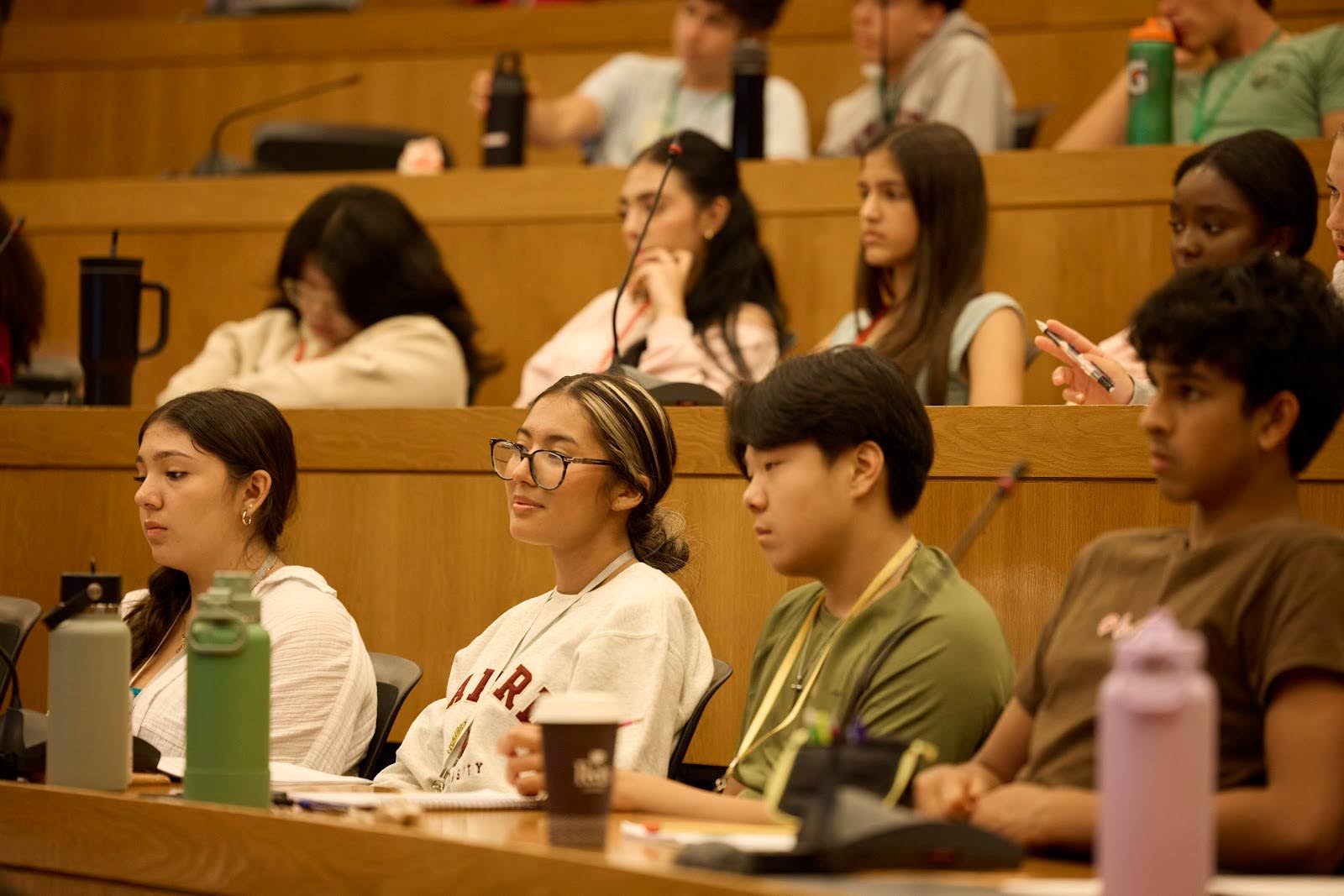Youth Summit on Climate, Equity, & Health brings climate optimism and inspires global action


Harvard Chan C-CHANGE Youth Summit on Climate, Equity, and Health

The Center for Climate, Health, and the Global Environment at Harvard T.H. Chan School of Public Health (Harvard Chan C-CHANGE) collaborates with Putney Pre-College every summer to organize a Youth Summit on Climate, Equity, and Health. The summit aims to bring together passionate high school students from around the world and train them to become climate and health leaders in their communities.
Program Overview
The weeklong program, which took place in July on the Harvard Chan campus, includes workshops, field-based activities, and meetings with experts from various fields. These experts include scientists, health and policy experts, academics, energy innovators, and climate communicators. The program is designed to empower students and equip them with the knowledge and skills needed to address climate-related issues in their own communities.
Participants
This year, the summit welcomed 67 high school students from 19 states and five countries (China, Greece, Taiwan, Uganda, United Kingdom). The participants come from diverse backgrounds and have varying levels of engagement in climate work. They were divided into groups based on their interests and focus areas, which include climate communications, press, and media; policy and advocacy; medicine and healthcare; entrepreneurship, industry, and tech; climate science; environmental justice; and global health, epidemiology, and infectious diseases.
Impact and Inspiration
Many students were inspired to join the program due to their personal experiences with climate events. For example, Kohana Henson, a 12th grader from New York City, was motivated by witnessing smoke in the sky and disruptions in train systems caused by flooding. She wanted to understand the reasons behind these events and learn how she can contribute to preventing them in the future. Similarly, Summer Bannigan, an 11th grader from Kansas, realized that her school curriculum lacked information about climate change and its impacts. This motivated her to educate herself and raise awareness among her peers.
Learning and Engagement
Throughout the week, students had the opportunity to learn from a wide range of guest speakers, including Harvard professors, social media creators, youth activists, healthcare professionals, and psychologists. The presentations went beyond the basics of climate and health, delving into the nuanced ways in which climate change can affect people’s lives and livelihoods. Topics discussed included the impact of climate change on lung health, the health challenges faced by migrant workers in extreme heat, and the disproportionate effects of climate change on prenatal development in frontline communities.
Keynote speeches encouraged interaction and dialogue between students and speakers, allowing for extended Q&A sessions.
Share this article
SDGs, Targets, and Indicators
1. Which SDGs are addressed or connected to the issues highlighted in the article?
- SDG 3: Good Health and Well-being
- SDG 4: Quality Education
- SDG 5: Gender Equality
- SDG 7: Affordable and Clean Energy
- SDG 10: Reduced Inequalities
- SDG 11: Sustainable Cities and Communities
- SDG 13: Climate Action
- SDG 17: Partnerships for the Goals
The article discusses the issues of climate, equity, and health, which are connected to multiple SDGs. These SDGs include SDG 3 (Good Health and Well-being), as the program aims to train students to become health leaders in their communities. SDG 4 (Quality Education) is addressed as the program provides workshops and educational activities for students. SDG 5 (Gender Equality) is relevant as the article mentions the participation of students from different countries and backgrounds. SDG 7 (Affordable and Clean Energy) is connected as the program focuses on entrepreneurship, industry, and tech in relation to climate action. SDG 10 (Reduced Inequalities) is addressed as the program aims to empower students from diverse backgrounds. SDG 11 (Sustainable Cities and Communities) is relevant as the program encourages students to develop climate action plans for their own communities. SDG 13 (Climate Action) is directly addressed as the program focuses on climate change and its impacts. Lastly, SDG 17 (Partnerships for the Goals) is relevant as the program brings together students, scientists, experts, and innovators to collaborate on climate and health issues.
2. What specific targets under those SDGs can be identified based on the article’s content?
- SDG 3.4: By 2030, reduce by one-third premature mortality from non-communicable diseases through prevention and treatment and promote mental health and well-being.
- SDG 4.7: By 2030, ensure that all learners acquire the knowledge and skills needed to promote sustainable development, including among others through education for sustainable development and sustainable lifestyles, human rights, gender equality, promotion of a culture of peace and non-violence, global citizenship and appreciation of cultural diversity and of culture’s contribution to sustainable development.
- SDG 5.5: Ensure women’s full and effective participation and equal opportunities for leadership at all levels of decision-making in political, economic, and public life.
- SDG 7.2: By 2030, increase substantially the share of renewable energy in the global energy mix.
- SDG 10.2: By 2030, empower and promote the social, economic and political inclusion of all, irrespective of age, sex, disability, race, ethnicity, origin, religion or economic or other status.
- SDG 11.2: By 2030, provide access to safe, affordable, accessible and sustainable transport systems for all, improving road safety, notably by expanding public transport, with special attention to the needs of those in vulnerable situations, women, children, persons with disabilities and older persons.
- SDG 13.1: Strengthen resilience and adaptive capacity to climate-related hazards and natural disasters in all countries.
- SDG 17.16: Enhance the Global Partnership for Sustainable Development, complemented by multi-stakeholder partnerships that mobilize and share knowledge, expertise, technology and financial resources, to support the achievement of the Sustainable Development Goals in all countries, in particular developing countries.
Based on the article’s content, specific targets under the mentioned SDGs can be identified. For SDG 3.4, the program aims to train students to become health leaders, promoting prevention and treatment of non-communicable diseases and mental well-being. SDG 4.7 is addressed through the educational activities provided to students, promoting knowledge and skills for sustainable development. SDG 5.5 is relevant as the program encourages equal opportunities for leadership among students, irrespective of gender. SDG 7.2 is connected as the program focuses on renewable energy and its role in addressing climate change. SDG 10.2 is addressed through the program’s aim to empower students from diverse backgrounds and promote inclusion. SDG 11.2 is relevant as the program encourages the development of sustainable transport systems and addresses the needs of vulnerable populations. SDG 13.1 is directly addressed as the program focuses on climate change and its impacts. SDG 17.16 is relevant as the program fosters partnerships and collaboration among students, experts, and innovators.
3. Are there any indicators mentioned or implied in the article that can be used to measure progress towards the identified targets?
- Number of students trained as climate and health leaders
- Number of workshops and educational activities provided to students
- Participation and representation of students from different countries and backgrounds
- Percentage increase in the share of renewable energy in the program’s activities
- Level of empowerment and inclusion of students from diverse backgrounds
- Accessibility and sustainability of the transport systems used during the program
- Level of resilience and adaptive capacity developed among students in relation to climate-related hazards
- Number of partnerships and collaborations established for climate and health initiatives
The article implies indicators that can be used to measure progress towards the identified targets. These indicators include the number of students trained as climate and health leaders, which can measure progress towards SDG 3.4. The number of workshops and educational activities provided to students can be an indicator for progress towards SDG 4.7. The participation and representation of students from different countries and backgrounds can measure progress towards SDG 5.5. The percentage increase in the share of renewable energy in the program’s activities can be an indicator for progress towards SDG 7.2. The level of empowerment and inclusion of students from diverse backgrounds can measure progress towards SDG 10.2. The accessibility and sustainability of the transport systems used during the program can be an indicator for progress towards SDG 11.2. The level of resilience and adaptive capacity developed among students in relation to climate-related hazards can measure progress towards SDG 13.1. Lastly, the number of partnerships and collaborations established for climate and health initiatives can be an indicator for progress towards SDG 17.16.
4. Table: SDGs, Targets, and Indicators
| SDGs | Targets | Indicators |
|---|---|---|
| SDG 3: Good Health and Well-being | 3.4: By 2030, reduce by one-third premature mortality from non-communicable diseases through prevention and treatment and promote mental health and well-being. | Number of students trained as climate and health leaders |
| SDG 4: Quality Education | 4.7: By 2030, ensure that all learners acquire the knowledge and skills needed to promote sustainable development, including among others through education for sustainable development and sustainable lifestyles, human rights, gender equality, promotion of a culture of peace and non-violence, global citizenship and appreciation of cultural diversity and of culture’s contribution to sustainable development. | Number of workshops and educational activities provided to students |
| SDG 5: Gender Equality | 5.5: Ensure women’s full and effective participation and equal opportunities for leadership at all levels of decision-making in political, economic, and public life. | Participation and representation of students from different countries and backgrounds |
| SDG 7: Affordable and Clean Energy | 7.2: By 2030, increase substantially the share of renewable energy in the global energy mix. | Percentage increase in the share of renewable energy in the program’s activities |
| SDG 10: Reduced Inequalities | 10.2: By 2030, empower and promote the social, economic and political inclusion of all, irrespective of age, sex, disability, race, ethnicity, origin, religion or economic or other status. | Level of empowerment and inclusion of students from diverse backgrounds |
| SDG 11: Sustainable Cities and Communities | 11.2: By 2030, provide access to safe, affordable, accessible and sustainable transport systems for all, improving road safety, notably by expanding public transport, with special attention to the needs of those in vulnerable situations, women, children, persons with disabilities and older persons. | Accessibility and sustainability of the transport systems used during the program |
| SDG 13: Climate Action | 13.1: Strengthen resilience and adaptive capacity to climate-related hazards and natural disasters in all countries. | Level of resilience and adaptive capacity developed among students in relation to climate-related hazards |
| SDG 17: Partnerships for the Goals | 17.16: Enhance the Global Partnership for Sustainable Development, complemented by multi-stakeholder partnerships that mobilize and share knowledge, expertise, technology and financial resources, to support the achievement of the Sustainable Development Goals in all countries, in particular developing countries. | Number of partnerships and collaborations established for climate and health initiatives |
Source: news.harvard.edu








